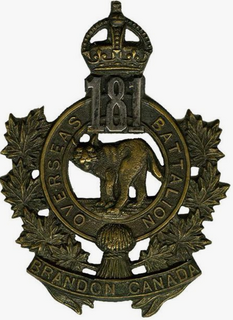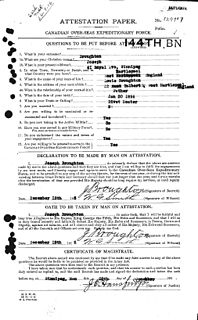Related Research Articles

The Fort Garry Horse is a Canadian Army Reserve armoured regiment based in Winnipeg, Manitoba, Canada. It is part of 3rd Canadian Division's 38 Canadian Brigade Group. It traces its history to a cavalry regiment first formed in 1912 that first took up the name "Fort Garry" a year afterwards. Since that time the regiment has served in the First World War, sending men to battalions of the Canadian Expeditionary Force, and as an armoured regiment in the Second World War.

The Royal Winnipeg Rifles are a Primary Reserve one-battalion infantry regiment of the Canadian Army. Nicknamed the "Little Black Devils", they are based at Minto Armoury in Winnipeg, Manitoba. The Royal Winnipeg Rifles are part of 3rd Canadian Division's 38 Canadian Brigade Group.

The 181st Battalion (Brandon), CEF was a unit in the Canadian Expeditionary Force during World War I.
The 128th Battalion, CEF was a unit in the Canadian Expeditionary Force during the First World War. Based in Moose Jaw, Saskatchewan, the unit began recruiting in late 1915 in that city and the surrounding district. After sailing to England in August 1916, the battalion was absorbed into the 15th and 19th Reserve Battalions on August 24, 1916. The 128th Battalion, CEF had one officer commanding: Lieutenant-Colonel Francis Pawlett.

§
The 203rd Battalion, CEF was a unit in the Canadian Expeditionary Force during the First World War. Based in Winnipeg, Manitoba, the unit began recruiting during the winter of 1915/16 in that city. After sailing to England in October 1916, the battalion was absorbed into the 18th Reserve Battalion on January 12, 1917. The 203rd Battalion, CEF had one Officer Commanding: Lieut-Col. Jeffrey E. Hansford.
The 222nd Battalion, CEF was a unit in the Canadian Expeditionary Force during the First World War. Based in Winnipeg, Manitoba, the unit began recruiting in early 1916 throughout the province. After sailing to England in November 1916 onboard the RMS Olympic, the battalion was absorbed into the 19th Reserve Battalion on January 2, 1917. The 222nd Battalion, CEF had one Officer Commanding: Lieut-Col. James Lightfoot.
The 26th Field Artillery Regiment, Royal Canadian Artillery, is a Canadian Army Primary Reserve artillery regiment based in Brandon and Portage la Prairie, Manitoba. 71 Field Battery, Headquarters and Service Battery, and Regimental Headquarters are in Brandon (49.8418°N 99.9532°W), and 13 Field Battery is in Portage la Prairie (49.9765°N 98.2875°W). Together with 10th Field Artillery Regiment, RCA and 116th Independent Field Battery, RCA, it forms the 38 Artillery Tactical Group within the 38 Canadian Brigade Group of 3rd Canadian Division.

The 12th Manitoba Dragoons is an armoured regiment of the Canadian Army that is currently on the Supplementary Order of Battle.
The 79th Battalion (Manitoba), CEF was an infantry battalion of the Canadian Expeditionary Force during the Great War. The 79th Battalion was authorized on 10 July 1915 and embarked for Britain on 24 April 1916. The battalion provided reinforcements to the Canadian Corps until it was absorbed by the 17th Reserve Battalion, CEF on 12 July 1916. The battalion was subsequently disbanded on 12 October 1917.
The 1st Battalion, Canadian Mounted Rifles, CEF, was an infantry battalion of the Canadian Army. Raised for service during the First World War as part of the Canadian Expeditionary Force (CEF), it was formed in November 1914, in Brandon, Manitoba. Originally a mounted infantry unit named the 1st Regiment, Canadian Mounted Rifles, CEF, which was expanded, following its rerolling and dismounting as an infantry unit, by absorbing other units of the Canadian Mounted Rifles (CMR).

The 5th Battalion, CEF, known as "Tuxford's Dandys," was an infantry battalion of the Canadian Expeditionary Force during the Great War.
The 6th Battalion, CEF was a battalion of the Canadian Expeditionary Force during the First World War.
The 32nd Battalion, CEF, was an infantry battalion of the Canadian Expeditionary Force during the Great War.

The 44th Battalion (Manitoba), CEF, was an infantry battalion of the Canadian Expeditionary Force during World War I.
The 45th Battalion (Manitoba), CEF, was an infantry battalion of the Canadian Expeditionary Force during the Great War.
The 65th Battalion (Saskatchewan), CEF was an infantry battalion of the Canadian Expeditionary Force during the Great War. The 65th Battalion was authorized on 20 April 1915 and embarked for Great Britain on 18 June 1916. Its personnel were absorbed by the 44th Battalion (Manitoba), CEF, 46th Battalion, CEF, 54th Battalion (Kootenay), CEF and 72nd Battalion, CEF of the 4th Canadian Division on 30 June 1916. The battalion was disbanded on 12 October 1917.

The 100th Battalion, CEF, was an infantry battalion of the Great War Canadian Expeditionary Force.
The Manitoba Horse was a cavalry regiment of the Non-Permanent Active Militia of the Canadian Militia. First formed in 1912 as the 32nd Light Horse, the regiment was redesignated later that same year as the 32nd Manitoba Horse and again in 1920 as The Manitoba Horse. In 1936, the regiment was amalgamated with The Fort Garry Horse.
The Saskatchewan Mounted Rifles was a cavalry regiment of the Non-Permanent Active Militia of the Canadian Militia. First formed in 1908 as the Saskatchewan Light Horse, the regiment was later Redesignated that year as the 22nd Saskatchewan Light Horse and again in 1920 as The Saskatchewan Mounted Rifles. In 1936, the regiment was amalgamated with the 16th Canadian Light Horse to form the 16th/22nd Saskatchewan Horse.
References
- Meek, John F. Over the Top! The Canadian Infantry in the First World War. Orangeville, Ont.: The Author, 1971.
- Library and Archives Canada - Soldiers of the First World War, CEF